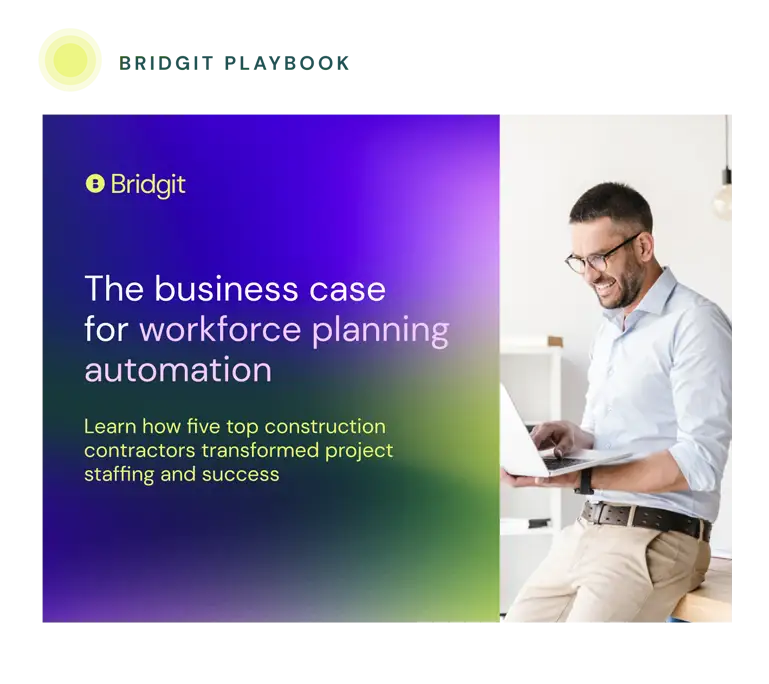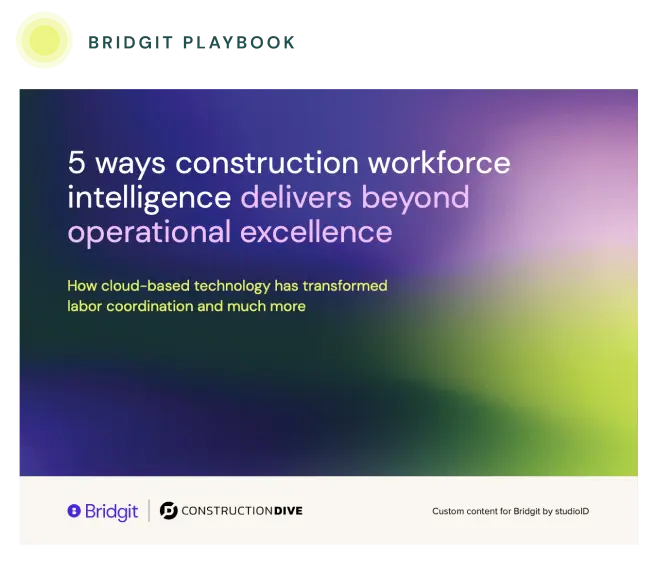Table of Contents
Effective project management in construction demands an understanding of how workforce planning influences the success of projects. The challenge is balancing project schedules with labor availability while maintaining tight control over budgets and deadlines. It requires foresight, strategy, and a grasp of the nuances that come with each project and team member.
This article will explore the importance of integrating workforce planning and project management. You’ll gain insights into how workforce planning tools like Bridgit Bench integrate more generally with business development, HR, and project management.
The importance of workforce planning in project management
Workforce planning is a major piece of the project management puzzle for a couple of reasons. Firstly, one of your major project costs is your labor—and with 49% of contractors reporting increased costs due to labor shortages, being strategic about how it’s used is more critical than ever. Secondly, people are at the heart of project delivery; it’s impossible to get a job done without people (or at least until AI gets smart enough).
When workforce planning fails, the impacts are severe: 42% of contractors can’t take on new projects, while 33% see their teams burning out from extended hours. You have to anticipate the skills needed for each phase of a project, manage the availability of your workers, and be compliant with safety regulations and labor laws—all while striving to meet deadlines that 32% of contractors are already struggling to hit.
Workforce planning also has tentacles in every aspect of project management since nothing can get done without staff. In preconstruction, you must ensure you have estimators, project managers, and procurement specialists. In the construction phase, you need to ensure that you have your labor in place and that it will be there on time so as not to cause delays. You must also have your project executives, superintendents, and project managers oversee everything. Since the need for staff is vital, your workforce plan extends to other teams, like business development and marketing, who need to know staff availability for pursuits and bids. Human Resources must also be updated with the workforce plan to develop recruiting strategies proactively.
Curious about how data-driven workforce planning can impact your business?
Download our playbook to learn how workforce intelligence can transform your workforce planning and labor coordination.
What is the difference between project management and workforce management?
Project management is about managing the work itself. It’s tracking project timelines, budgets, materials, and deliverables. When you’re using tools like Procore or Autodesk, you’re managing project schedules, RFIs, submittals, and making sure the job gets done on time and on budget. It’s about the what, when, and how much of construction projects.
Workforce management is about managing the people who do that work. It’s figuring out who’s available, what skills they have, where they’re certified to work, and making sure you have the right crew on each job site. While project management asks “what needs to get done,” workforce management asks “who’s going to do it.” You need both working together because even the best project plan falls apart without the right people in place to execute it.
Integrating workforce planning and project management
Streamlining the workforce planning process with the other components of project management can be tricky with traditional methods like spreadsheets and whiteboards. These methods rely on manual data entry and don’t “talk” to your other systems. The result is data and collaboration silos causing slowdowns and blind spots. Specialized workforce planning platforms like Bridgit Bench can help you eliminate these issues, making it easy to see all your people and project information in a centralized place.
A workforce planning tool is only half the battle; you still have broader project management systems like Procore or Autodesk. You still have HRIS systems and CRMs. These platforms house a wide range of data that uses your people and project information. The key is to have these systems communicate with your workforce planning platform. With Bridgit Bench, you can integrate your project management, CRM, and HRIS software to set up a clean workflow.
Project management with Procore and Bench
When integrated with Procore, Bridgit Bench simplifies managing your resources and workforce directly within Procore. You get a clear view of your project management activities, with workforce data directly influencing your project planning. This integration offers a detailed and broad view of your project pipeline. It automatically moves important project details between the applications, like project dates, custom fields, necessary roles, and phase dates.
The key advantages include better productivity because you don’t have to manually add projects to Bridgit Bench, which saves time and reduces errors. It also supports proactive thinking by transferring potential project opportunities from Procore, allowing you to set up your team in advance. Additionally, based on what works best for you, you have control over how often your project information is updated, whether every few minutes or days.
Learn more about our Procore integration here.
CRM integration with Unanet and Salesforce
Bridgit Bench integrates with both Salesforce and Unanet CRM, allowing you to import project data at any stage, whether during bidding or after agreements are finalized and can be customized to include various fields like region and square footage.
Key benefits of a CRM integration include:
- Improved workflow efficiency
- Faster response to stakeholder requests
- Elimination of double-entry errors
- Detailed view of staff allocation up to five years in advance
Wohlsen Construction is a practical example of the benefits of integrating with Unanet CRM. The improved visibility into different project phases has led to informed decision-making because of more reliable data. It helps them handle “what-if” scenarios effectively because they can immediately see the impact of a pursuit on their staffing plan. This capability allows for learning on the fly and evaluating go/no-go scenarios quickly and accurately.

Automate your workforce planning and create a competitive advantage
Download our playbook to learn how five top contractors have transformed their workforce planning process, improved project staffing, and fostered a more collaborative planning process at the same time.
HR coordination with ADP
The integration between Bridgit Bench and ADP Workforce Now enhances the process of syncing workforce data across platforms. This feature allows for the easy importation of crucial people data, including:
- New hire start dates,
- Termination dates
- Title changes
By pulling new hire information into Bridgit Bench, including official start dates, you can plan out projects and roles for new employees, setting them up for success before their first day. You’ll also be able to capture changes in employees’ titles and salaries as they progress within the organization. This automation reduces manual work and promotes better collaboration with HR teams.
Learn more about our ADP integration here.
Project management in construction is rooted in the holistic integration of operations, business development, and HR, with the effective use of your people at the very heart of it. Creating a thread between these components controls costs and drives the successful completion of projects.



